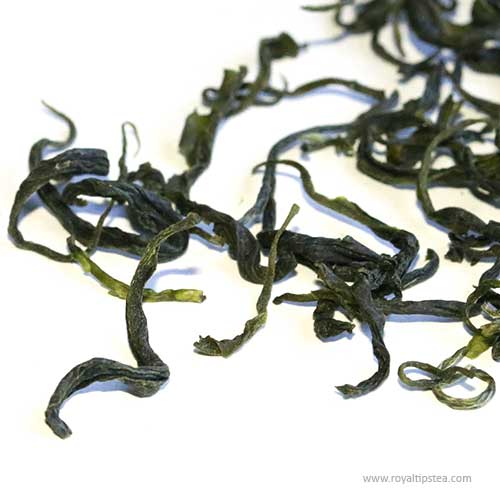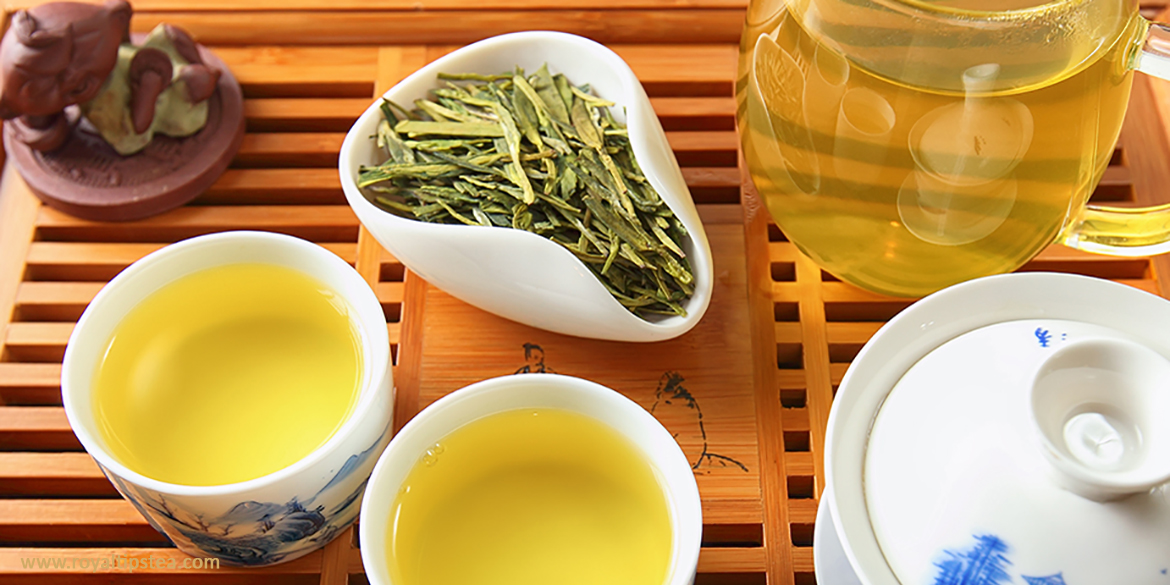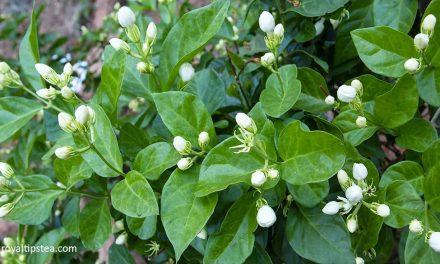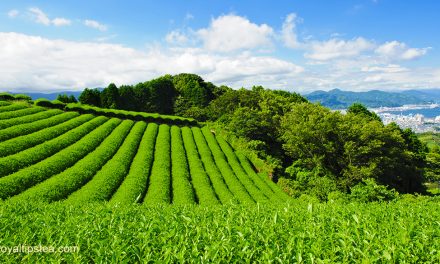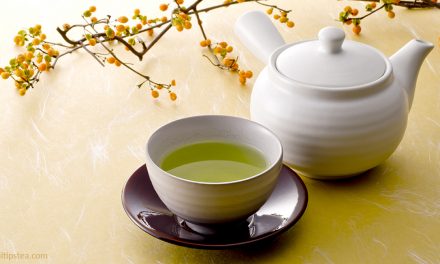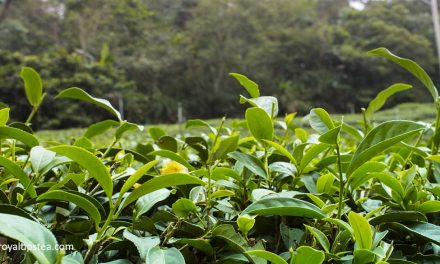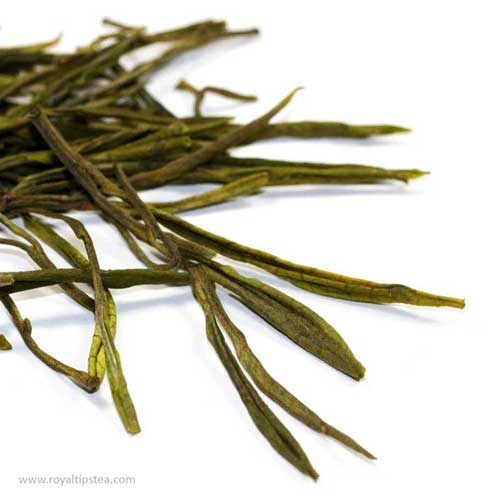
1. Anji Bai Cha (Anji White Tea)
Although the name of this exquisite tea means ‘white tea’, it is in fact a green tea. It is called white because the varietal of the tea plant used to make it produces very little chlorophyll and so the leaves are very pale. As new buds form in the early spring, they look almost white or translucent in the morning sun. The particular varietal was discovered in 1982 in Anji county, Zhejiang province, and to make the tea, young shoots of one bud and one or two leaves are picked right at the beginning of the growing season, then de-enzymed in a hot wok, rolled by hand or in a panning machine, then dried. The long, elegant, pointed dry leaves look like pine needles. The tea contains high levels of amino acids so is sweet and smooth.
2. Longjing (Dragon Well)
Long Jing is also made in the West lake region of Zhejiang province and is processed by hand using a heated wok to carry out the three important processing steps required to make green tea – panning to stop oxidation, pressing to develop flavor, drying to remove all but 2-3% of water in the leaves. Tea makers use their flat hands to move the little bud sets around the pan and, when they have finished, each tea bud is flat and shiny and yellow-green. The brew is sweet and smooth, with hints of young green vegetables such as broccoli, asparagus and pea-pods. The legend of Long Jing says that the Emperor visited the Hu Gong Temple in West Lake one day and was presented with a bowl of the tea. He was so impressed by the delicious taste and aroma that he gave ‘imperial status’ to the 18 tea bushes growing in front of the temple.
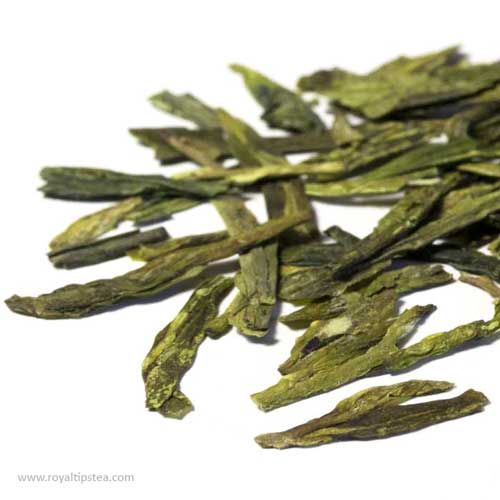
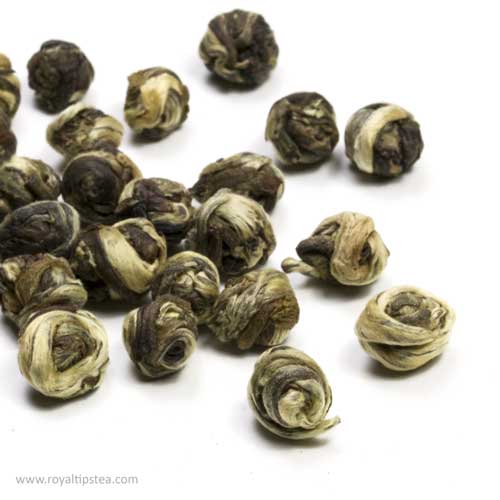
3. Jasmine Pearls
Loose Jasmine teas and Jasmine Pearls are made in Fujian province. To make loose green tea, the freshly picked tea shoots are withered for a couple of hours, then panned to stop oxidation, lightly rolled, and then dried. To make the little pearls, little shoots of one bud and 2 tiny leaves are withered briefly, panned and lightly rolled. Then two or three small shoots are gathered together and rolled by hand into neat little balls. Each pearl is then wrapped in tissue paper to hold the shape while the tea is dried. The best teas are made in the early spring and then are very carefully stored. The jasmine flowers bloom in July and August and sprigs of flowers are cut during the day, taken into the factory and, in the evening when the flowers open, all the blossoms are taken off the branches. The tea is then brought out of storage and the jasmine flowers are layered with the tea. The heaped tea and flowers can become quite hot so, during the night, so the layers of tea and flowers must be spread out to allow them to cool and then they are re-heaped. The best jasmine teas are flavoured 8 or 9 times over 8 or 9 nights, each time with a new batch of fresh jasmine blossoms.
4. Mao Jian (Jade Tips)
Mao Jian comes from Henan province and is a very tippy tea with a lovely sweet taste. The word ‘mao’ refers to the downy covering on the little buds and baby leaves; ‘jian’ refers to the shape of the leaves which are pointed and sharp. It is made in the spring and autumn but the best are those picked in early April, before the rains come, when the growth is still slow. When the weather is cool and there is very little rain, the new buds develop very slowly and so concentrate sweetness and subtle flavor in the new flush. It takes approximately 50,000 little bud shoots to make 50 grams of tea.
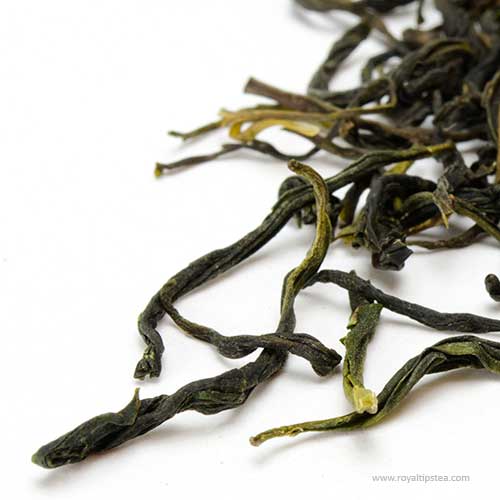
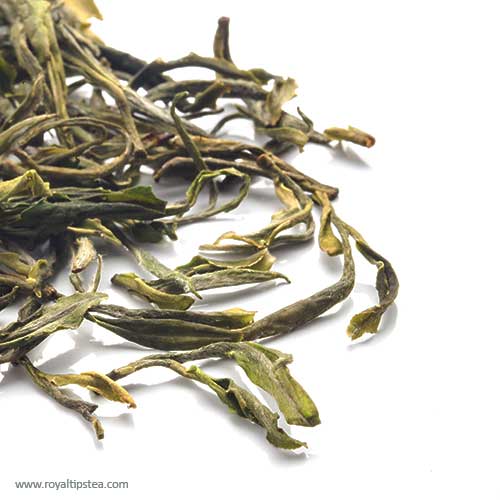
5. Huang Shan Mao Feng (Yellow Mountain Fur Peak)
This famous tea comes from Huang Shan (Yellow Mountain) in Anhui province where Keemun black tea is produced. The same varietal of the tea plant is used to make both black Keemun Mao Feng and green Mao Feng. The word ‘mao’ comes from the little white furry hairs on the outside of the tiny buds, and ‘feng’ means peak, referring to the pointed tip of the bud which looks like the peak of a mountain. The best quality teas are harvested in late March, early April, before the Qing Ming Festival of Pure Light (also called the Tomb Sweeping Festival) which falls on 4th or 5th April each year.
6. Taiping Hou Qui (Taiping Monkey King)
The story behind this rare and famous tea (only recently available in the West), tells how monkeys in the mountain area where the teas are made were very mischievous and used to damage the farmers’ crops. One day a young monkey went missing and the father monkey looked everywhere for his son, but could not find him and collapsed, tired out, in the mountains. Mr Wang Loa’r, one of the local farmers, found the exhausted father monkey and took him to his home to treat him with herbal cures. When he recovered, the father monkey was so grateful that he promised to make sure that in the future his fellow monkeys helped the farmers to pick their tea. So Mr Wang named his tea Taiping Monkey King. The tea is made from a tea varietal with very long bud and leaves and so the dried tea is almost like long green spears. The process involves panning the tea and then pressing the shoots between fine wire mesh stretched across a wooden frame. Some manufacturers use a muslin cloth to protect the leaves and, after drying, the leaves bear the criss-cross pattern of the wire mesh or muslin cloth. The tea needs to be brewed in a tall glass or large teapot because the leaves are so long.
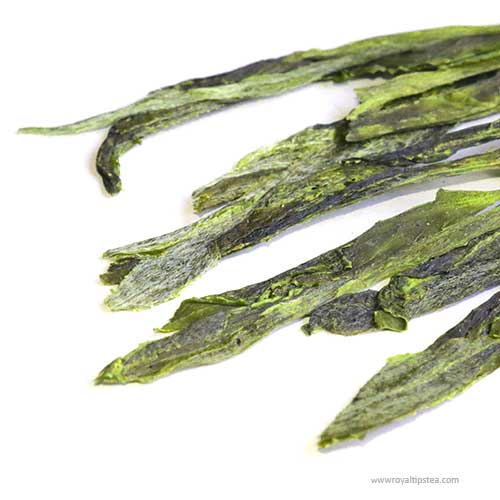
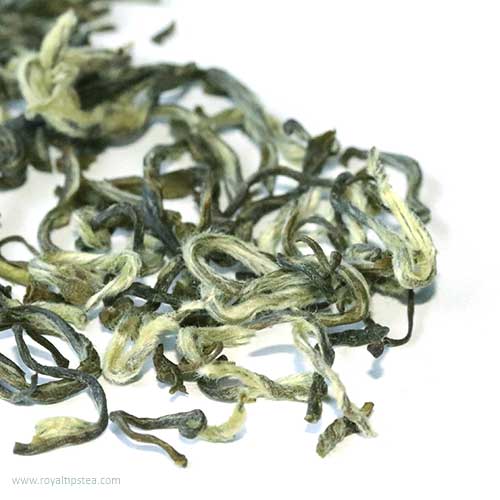
7. Bi Luo Chun (Green Snail Spring)
The tiny spirals of downy buds of this delicate tea are produced in the Dongting mountains of Jiangsu province. It takes between 14,000 and 15,000 baby shoots to make one kilo of Bi Luo Chun green tea and the names comes from the fact that the little curls of spring-picked buds look like tiny snail shells. The best teas are processed by hand and the tea masters who make them pan them in hot woks, then as the tea gently dries, they shape the leaves into small twisted curls by rolling them carefully between the palms of their hands. The silver-green leaves have a floral aroma and brew a liquor that is slightly nutty, fruity, sweet and smooth.
8. Liu An Gua Pian (Little Melon Seed)
Made in Anhui province, this tea has a long history dating back to the 8th century AD. During the Qing Dynasty (1644 to 1912) it was a tribute tea presented to the Emperor and his family. The name has become confused over time. At first called ‘sunflower seed slice’ because of the shape of the curled green leaves, the name was shortened to Guan Pian which means ‘water melon slice’. The pluckers harvest only mature open leaves approximately 4cm long, with no stems or buds. The leaves are then withered for a couple of hours, then panned and dried in wok, and as they dry they are stirred round and round with bamboo brushes which give the leaves a slightly curled shape. The tea is given a final drying in bamboo baskets that are placed repeatedly for just a few seconds each time over smouldering charcoal. The taste is quite strong, sweet and very round in the mouth, with a little astringency. The charcoal roasting gives the tea a unique depth and complexity unusual in green teas.
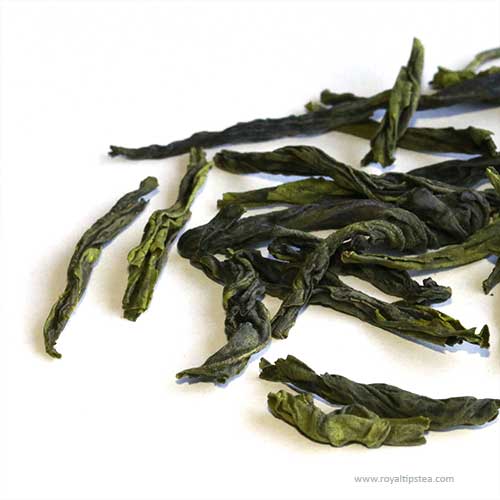
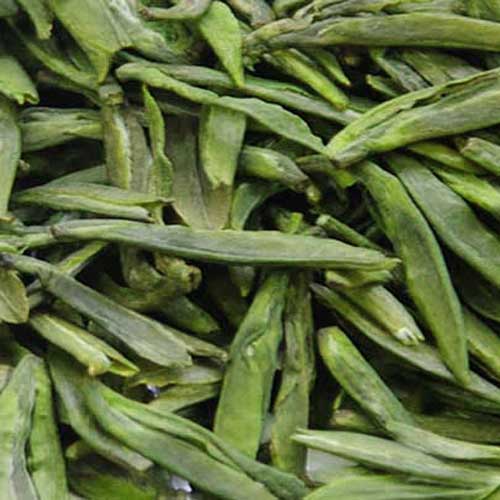
9. Zhu Ye Qing (Bamboo Green Tea)
This rare green tea is grown at altitudes of around 3000 metres on misty Emei Shan (Emei Mountain) in Sichuan province and is said to have first been made at a temple there. When a Chinese army general visited the temple in 1964, he was asked to give the tea a name and he chose the name Green Bamboo because he thought the little buds and leaves had the appearance of young bamboo leaves. The little glossy buds really look just like tiny pea pods. Plucking starts in late March and goes on until the end of April and the pickers gather little shoots of one tiny bud with a small leaf attached. The tea liquor is greeny-gold and the flavour is clean, elegant, lightly astringent and with hints of bamboo shoots, young asparagus and chestnuts.
10. Tian Mu Yun Wu (Clouds and Mist from Tian Mu Mountain)
The deep green, curly leaves of Tian Mu Yun Wu are produced in Tian Mu Mountain in Zhejiang province. Little shoots of one bud and one leaf are harvested in early April and it takes about 62,000 baby shoots to make one kilo of tea. The clouds and mist that swirl around the mountain all the time cut out a lot of the sunlight and this means that fewer of the sweet amino acids in the tea leaves are converted to bitter polyphenols, so the tea is always sweet, mild and smooth, with a pleasant lingering aftertaste. Brew the little buds in a tall glass to see them slowly absorb water and then drift elegantly down to the bottom of the glass, their pointed tips uppermost, and then rest there, waving like tiny sea anemones.
